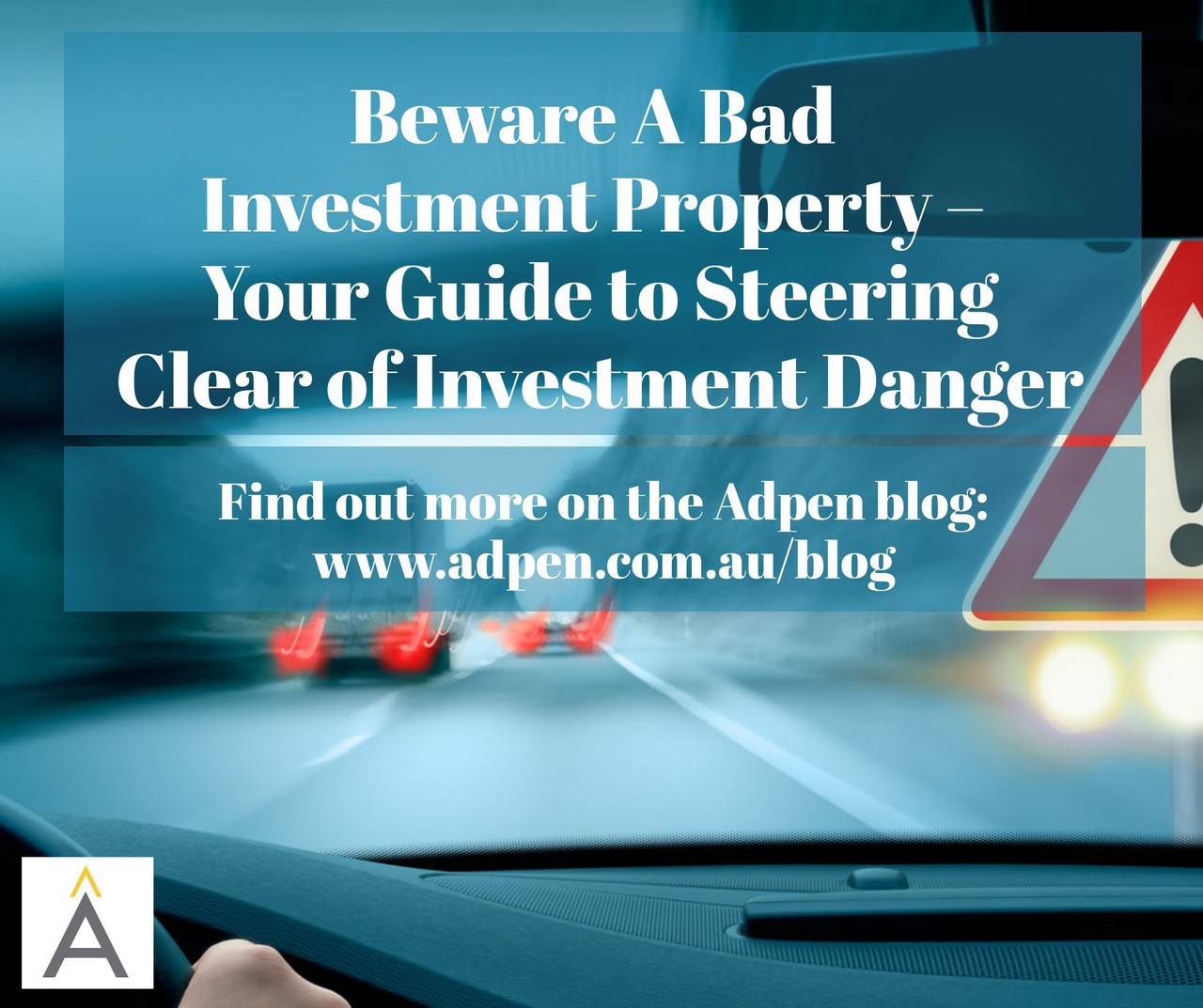The old adage says, “when life gives you lemons, make lemonade”, but there are some lemons that you should steer clear of at all costs, such as bad investment properties. Buying an investment lemon can create a financial hole that’s near impossible to climb out of, so it’s crucial that you educate yourself on what they are and how to spot them early.
The point of an investment property is to make money over time through some combination of rent and (hopefully) steadily increasing property value. However, properties that require high expenditure to maintain, make marketable, or are set to lose value significantly in the future, will eat into your ability to make a profit.
Cash flow is the most important consideration, not eventual capital growth. If the property’s rent is insufficient to cover the mortgage and maintenance costs then you will have to expend additional finances to cover the loss. In this case, your investment becomes an ongoing expense rather than an income source.
Symptoms of a possible lemon
Here is our list of the warning signs you should look for if you want to avoid a property investment catastrophe.
Long time on the market
- Investigate the marketing history of the property
- Has the property failed at auction, been listed for a long time across several agencies etc.?
- If a property has been failing to sell for an extended period, there may be something wrong with it (or the location)
Numbers that don’t make sense on paper
- Asking price is too high for how long it has been on the market
- Similarly, be wary of “bargain” prices without an explanation for the low valuation
- This can indicate an undisclosed problem with the property or surrounding area
- If the seller can’t or won’t provide verifiable/hard statistics (as opposed to guesswork or ‘estimates’) on rentals vs. vacancy rates, neighbourhood allure, year to year profits etc. it is likely that the success rate for rentals in the building/area is low.
- Investment should be a calculated risk – never enter a blind deal
Poor or non-compliant build work
- It’s worth getting a reputable builder to inspect the construction property for any flaws in the structure. Similarly, having a pest inspector check the property can help identify any problems before purchase.
- This can help identify and avoid building flaws that would require a full rebuild or expensive renovation/reinforcement to correct
- Small but non-serious flaws may allow you to negotiate a better price if the vendor is not aware of them
- Seek compliance and occupancy certificates with the relevant council if the property has had work done and make providing them a condition of sale
- Illegal outbuildings, granny-flats, sheds or extensions can be a turn-off for future buyers
- Non-compliant building components can also create problems with insuring the property
- May also create legal problems if you plan on letting out the building to several tenants at once (e.g. in the case of a non-standard second floor or illegal granny-flat)
- Remember, any work you have to do in removing non-compliant elements or bringing them up to a compliant standard will eat into your profit margin
Lack of maintenance / high initial repair costs
- When inspecting, check the entire house and systems for signs of poor maintenance or neglect
- Rot or damp in the walls/ window frames, faulty lighting or electrical systems, insufficient power-points, leaky/unreliable gas lines/plumbing/hot-water systems, poorly maintained guttering, insufficient ventilation etc.
- Additional investment spent on removing, replacing or correcting outdated, faulty or inadequate features/utilities just to make the house marketable will cut into its profitability
- A few fixes or modernisations is fine, but a property in decline or one that has been neglected for far too long may be more trouble than it’s worth to fix
Messy or confusing floor plan
- Counter-intuitive or confused room layouts, poor room-size ratios (especially in the case of undersized bedrooms or living spaces) and a lack of important spaces (such as an outdoor area) can be off-putting to renters and make it difficult to acquire high-paying tenants
- Properties requiring anything more than simple renovations to correct poor layouts will quickly burn through any initial discount that the poor floor plan may have provided
- Properties that require internal lighting on a bright day may be suffering from poor window placement, which can also produce airflow and ventilation problems
Difficulty securing an inspection/lack of internal photos
- Difficulty securing inspection may indicate that something is amiss – e.g. uncooperative tenants, reluctant vendors, poor communication within the agency, or that the listing agent is already considering another offer
- If you’re unable to contact the agent, another agent within the company, the vendor or the vendor’s solicitor, then it might be time to move on
- Lack of access generally means that either the agent can’t gain access or that the interior is unattractive/poorly maintained/messy enough to turn off buyers
- Make sure you secure an inspection if you can’t view internal photos
Development or planned development nearby
- Check via council to find out what’s happening and be up-to-date with any building or changes that may likely affect the future value (vacant blocks, neighbouring structural renovations, planned large developments or major roads, recent rezoning changes)
- The agent/conveyancer/solicitor is not obligated to check this for you unless you specifically request it
- Multiple sales in the immediate vicinity can be a warning sign of an oncoming value-reducing change to the area, so be sure to investigate if current investors or homeowners are bailing
Tricky contracts
- Be sure to obtain a copy of the sales contract and check out the basic terms as soon as you are considering the property for purchase
- Vendors may be sneakily passing on their land tax costs or putting conditions on the sale that disadvantage the buyer
- Having the contract reviewed early by a licensed conveyancer/solicitor can help you prepare terms for negotiation
Stigmatised blocks
- Houses where there has been a suicide, murder, drug bust, or other dramatic event are considered “stigmatised”
- Stigmatised house values may be reduced by 20 to 30% of their normal sale price
- You may not have any qualms about buying (especially with that discount), but the property reputation may discourage tenants or future buyers
- Worried that you may purchase a stigmatised property? Selling agents are obliged to reveal all “material facts” about a property, so they should inform you of any stigma around the property
Location Red Flags
In addition to the indicators already listed, there are signals to watch out for specifically in regards to the location of the property.
Bad areas
The whole purpose of investment properties is to buy somewhere that is either going to increase in value, or is desirable for renters. Investing in an area with a reputation for being poor, slummy, or in decline will not be profitable. Even if the problems have since been resolved, the area may still have a stigma that will make it hard to attract clients while charging sufficient rent to cover the investment cost.
Properties located in industrial zones or next to main roads are often unattractive to prospective renters and will be difficult to acquire well-paying tenants for. This is also true for properties located a long distance away from important services, conveniences and infrastructure such as shops, schools, public transport, etc.
One-industry towns
Properties in areas where the vast majority of employment and service is based on a single industry carry more long-term risk. These areas are more susceptible to dropping in value if shifts in the industry/economy cause the central industry to falter especially if the area’s only real source of value for the area is the presence of that industry. For example, a town built to service a local mine will drop in value when that mine is eventually exhausted or closed.
Investment in single-industry locations can be workable if you have knowledge of that industry and can leverage it to gain an advantage, but even then, it’s not advisable to construct an entire portfolio around these locations. Passive investors (those without industry-specific knowledge) would be better off investing in regions supported by multiple industries.
Chasing Hotspots
This idea is to buy into a location that is predicted to increase in value/desirability in the future, or one that is only just taking off. Buying in ahead of the hot-spot peak allows the property value to increase above its cost and may allow you to raise rent (or at least secure more tenants)
This can be viable as a short-term strategy, however, this strategy usually requires you to buy in before the hotspot takes off, which means a certain degree of fortune-telling.
Buying in too late can mean an expensive deposit for a property whose value increase is already beginning to plateau. In this case, the property’s final valuation may not be worth much more than your initial payment, which is certainly undesirable. The property may not undergo another boom for many years.
In the worst case scenario, the boom can be followed by a bust in which values drop back to or below previous prices. Buying in at the height of the boom, in this case, may cause your property to quickly lose value, making it hard to re-sell for any profit. If you’re wrong in your predictions and the area doesn’t take off you may not get much value out of rental returns or reselling the property.
Unlike stocks or bonds and shares, property is expensive to both purchase and sell: 5-6% costs of purchase, 2-3% cost of disposal plus the capital gains tax implications. As a result, chasing short-term investment strategies involving buying in ahead of a hotspot and selling at the height in order to invest at the next predicted hotspot may not return the best profits. Often, buying a long-term property in an area with consistent growth proves more profitable in the long term.
Look for a selling point
“Clone properties” are ones that have little to no unique features. It can be hard to attract renters or future buyers to generic or standardised units in massive complexes or housing developments, especially if there is an abundance of similar properties in the immediate area. If all the properties on offer are essentially identical, consumer choice will be reduced to a calculation of which is the most economical, and that doesn’t favour sellers.
Try to obtain properties which have at least a few unique features (architecture, land, aspect etc.) that can be used as selling points. You want to be able to differentiate your property from the competition.
Don’t only look at new properties
Limiting your market and research to newly-constructed properties can skew your perception of the area value and of the worth of your prospective investment property. A group of new properties selling well in an area doesn’t guarantee that those properties are worth that price – they may simply have been very well marketed.
A good way to check whether the property of interest is within the correct price range is to compare the asking price to the valuations on renovated second-hand properties in the same area. This will let you gauge whether the premium paid for a new property is worth it.
Keep in mind that a disproportionately large price gap can indicate problems. Assessing sales of second-hand properties in the area is also a good way to find out whether the property you are considering suits the needs/desires of the local tenant/future buyer demographic.
Be careful of areas sold predominantly to investors
Property investors and homeowners have different priorities in purchasing, maintaining, and reselling/renting properties. In times of economic downturn, other investors may sell or rent at under market value to recoup capital. This can have a flow-on effect that devalues properties in the same block or surrounding area.
If an area is predominantly or wholly composed of investment properties it may be symptomatic of a housing bubble. Perceived value may be driving the price far higher than what they are actually worth. It may also be symptomatic of an oversupply of housing with little demand from homeowners or renters.
Having said that, a high percentage of investment properties does not guarantee a bubble. Some areas may be investment-heavy due to a prevalence of short-term rental clients (holidaymakers or visiting businesspeople) or being more desirable to renters. For example, inner city properties or tourism destinations may not be as desirable to homeowners due to the crowded conditions and heavy noise pollution.
While a disproportionate number of investment properties relative to homeowners may have a genuine cause, such areas are worth investigating to be sure that the properties are worth their valued price.
Be wary of guaranteed rental returns
Properties advertised as having “guaranteed rental returns” as a major selling point should be regarded with suspicion and thoroughly researched, as this tactic is often used to market and sell an overpriced property.
Some sellers will artificially inflate the rental price for the guaranteed period in order to bump up the property price. Some sellers who do this may cover the difference between the real and advertised rental price during the guaranteed period, but this return rarely compensates for the funds lost to the inflated property price.
If you are able to buy a desirable property in a good location you probably won’t need a rental return guarantee to gain tenants. However, seeing a guaranteed rental return does not automatically mean that the seller is intentionally misleading customers or overpricing the property. These offers can be genuine, but determining legitimate guaranteed rental returns from marketing tactics requires research.
How to deal with a bad investments
Despite our best efforts, we may still overlook a crucial detail and end up the reluctant owners of a lemon. If you come to this conclusion, stay calm and remember that everyone makes mistakes. Treat it as a learning experience and try to identify how you ended up in the situation so you can recognise and avoid those traps next time. There’s always something to be gained from difficult situations!
To recover from this position:
- Try to remove emotion or emotional attachment to the property from the picture
- Seek professional advice from trusted sources
- Look for opportunities and pick a goal that offers the best possible outcome to move forward
You can also try these resources if you’re looking for advice if you’ve made a bad investment:
https://binvested.com.au/recovering-from-bad-investment-purchases/
https://www.yourinvestmentpropertymag.com.au/mistakes/invested-in-a-dud-property-what-you-can-do-next-175329.aspx
Be patient, be selective
It may seem after reading this article that property development is a minefield, with so many dangers to avoid. I don’t want to sugar-coat the seriousness of the selection process, as I know from personal experience that there are some properties that, once bought, will never turn a profit. However, with the right information (such as the advice in this blog), you can equip yourself so you can find the good properties – the ones that are going to reward your investment.
So with this guide in hand, you know what to do. Waiting until you find the right property is worth the patience, and you can get yourself into some trouble by rushing in. Now, when you find a property that ticks all the boxes, you’ll be able to take action with confidence. Contact us if you’d like to find out more about how to find your ideal investment property.






